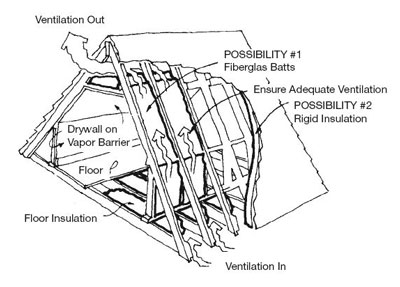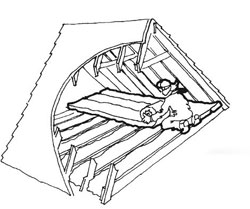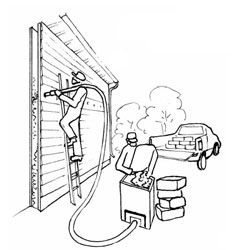Insulation is your primary defense against heat loss through the house envelope. Heat losses through the wall, roof, and floor together amount to over 45% of all the heat a typical house loses. In the summer, heat entering through the roof and walls in particular account for one-fourth of your cooling needs. See Table 2.1 for recommended insulation levels for your climate.
Putting insulation into a house after it is built can be pretty difficult. Because of the large area involved, walls are most important. You may be able to tell if the walls are insulated by removing an outlet cover and peering into the wall cavity. Another way to check for insulation is to find a closet (or cabinet) along an exterior wall. Drill two 1⁄4" holes into the wall about 4” apart, with one hole above the other. Shine a flashlight into one hole while looking into the other, and any insulation should be apparent. If there isn’t any insulation, the best option is to bring in an insulation contractor to blow cellulose or fiberglass into the walls.
Adding insulation to an unheated attic is usually a lot easier. If there is no floor in the attic, simply add more insulation, either loose fill or unfaced fiberglass batts. If the existing insulation comes up to the top of the joists, add an additional layer of unfaced batts across the joists. This helps to cover gaps between the first layer of batts. If an attic floor is in place, you may need to remove that floor before adding insulation (be very careful not to step through the ceiling below!). In most of the country, a full foot of fiberglass or cellulose insulation is cost-effective in the attic floor.

Insulating a sloped ceiling in a finished attic can be done from the inside, or by installing foam and new roofing on the outside.
If the attic is finished with a sloped cathedral ceiling, adding extra insulation is much more difficult. If there is no insulation there at present, it may be worth pulling off the drywall, insulating, and installing a new ceiling. Or, if you will be reroofing in the near future, consider adding a layer of rigid foam insulation and decking on top of the existing roof and then shingling over that. In either case, it’s a major project, and you will probably have to bring in a contractor to do the work. If there is already some insulation in the roof, it may be hard to justify the cost of this work, in which case you can focus your energy efforts elsewhere.
In the basement, heat loss through foundation walls is often neglected even in new houses. But in fact, in an otherwise well-insulated and tight house, as much as 20% of the total heat loss can occur through uninsulated foundation walls. Insulating the foundation or floor can easily save several hundred gallons of oil or several hundred therms of gas per year in northern climates.
Increasingly, building codes require basement insulation, and it is essential for basements used as living spaces in almost all climates. However, controlling moisture in these below-ground spaces is a real challenge and complicates the insulation process. Moisture-related failures of basement insulation can give rise to mold, mildew, and other problems.
Materials that could be damaged by moisture, such as fiberglass batts and cellulose, should rarely be used to insulate a basement. Interior vapor barriers can also be very damaging because they prevent basements from drying to the inside. Interior basement insulation should start with rigid foam installed against the basement walls.
If you have a crawl space, it should be sealed rather than ventilated, in most climates. To do this, use 6 mm thick polyethylene sheeting as a moisture barrier to cover the ground and seal tightly to walls and columns. Then use rigid foam to insulate the foundation walls. In the South, it is important to keep an uninsulated band for inspection of possible termite tunnels.
If you are considering finishing your basement and using it as a living space, seek the advice of an experienced professional. Because of the challenges inherent in constructing basement wall systems that can provide healthy and comfortable conditions, it may make more sense to build an above-grade addition to your house, rather than trying to make the basement livable.
State of the Art
“Super-Insulation” Retrofit. Super-insulation retrofits refer to home improvements that go the extra mile to reduce the energy required to heat and cool a home. Such retrofits could involve the addition of 3–4 inches of rigid foam to exterior walls; boosting attic insulation to R-40 or more; replacement of windows with high-performance, low-e windows or the addition of low-e storm windows; thorough airtightening; and accounting for moisture problems. To achieve the aggressive 50% reduction in residential energy consumption that experts use as a target to prevent catastrophic climate change, this level of retrofit would be needed, especially in cold climates. Costs of such retrofits would be high (likely $50,000 per house) unless combined with other general remodeling.
Contact: BuildingGreen
Green Roof Systems. Green roof systems are a way to insulate your roof that brings several added benefits. It may be something for you to consider if you have a low slope or flat roof and are retrofitting your roof. Green roofs protect the roof membrane, reduce stormwater flows, and help green the built environment through rooftop plantings. They are good for energy efficiency and local temperature regulation because they both transmit less heat than conventional roofs and reflect or radiate less heat back into the local environment. Most roofs are not built to withstand the weight of a functional green roof, so installations on existing homes may require extra effort to shore up the roof.
Contact: Green Roofs for Healthy Cities



